|
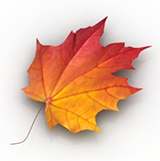 Here we are again near the end of another camping season. Most of us will remember this summer as rainy at first but then scorching HOT but many will remember this summer for the record-setting series of wildfires. Some fires started as early as March and we saw an increased intensity in June. All 13 provinces and territories were affected, with large fires in Alberta, British Columbia, the Northwest Territories, Nova Scotia, Ontario, and Quebec. We wish all the best to those impacted by those devastating wildfires! Here we are again near the end of another camping season. Most of us will remember this summer as rainy at first but then scorching HOT but many will remember this summer for the record-setting series of wildfires. Some fires started as early as March and we saw an increased intensity in June. All 13 provinces and territories were affected, with large fires in Alberta, British Columbia, the Northwest Territories, Nova Scotia, Ontario, and Quebec. We wish all the best to those impacted by those devastating wildfires!
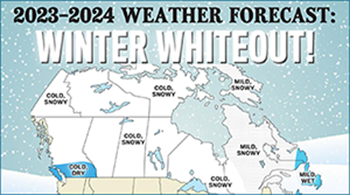
Now the geese are flying south and the leaves are slowly changing colors. Old man winter is on his way again and according to the Farmer's Almanac, Canadians should expect lots of that fluffy white stuff coupled with seasonably chilly temperatures at or below normal. You can read more about this here.
While you're relaxing indoors during those long winter months, why not help out your fellow campers by rating the campgrounds rating the campgrounds that you visited this summer using our "5-point" rating system. As explained below, 78% of consumers trust other people's recommendations and that is even more true for holiday accommodation. To rate a campground, simply use our campground search engine to locate the campground (at the moment, we have 1500+ ratings and more than 400 reviews for our 2000+ campgrounds).
Please note that we recently added two new features to our campground ratings tool. One allows you to add photos to your campground reviews and the other one allows you to store personal notes within your reviews in your own personal camping journal. "Click here" to read existing reviews or to review a campground.
If you want to read about the RV market, click here to read about the various types (classes) of RVs available out there. You can buy a "towable" RV or you can buy a "motorized" RV. You can have slideouts, AC, bunk beds.... or hundreds of other options. You can buy a 12 footer or you can buy a 45 footer. It all depends on your needs and to help you with your buying process, we have put together an "RV selection guide" as well as two checklists; our "RV shopping checklist" and our "Buying a used RV checklist". Print these and bring them with you on your next shopping trip!
Selling or looking for an RV or camping gear?
If you're interested in selling or buying an RV or camping gear, check out our free "Classifieds" section.
|

"KampMAP"!
Another recent feature that we added is the "KampMAP" which is a tool that allows you to visually keep track of all the campgrounds that you have visited and reviewed to date using our campground review tool. It basically works like this.......every time you review one of our campgrounds, we create a new marker on your own KampMAP (a Google map) which includes information for this campground as well as a link to it's listing, a link to your own review and a link to all the reviews done to date for this campground. The map is fully interactive with zoom-in, zoom-out features.
|
| |
|
|
|
| Upcoming Canadian RV shows |
|
|
Information above provided by organizers / third parties. Camping Canada does not warrant or guarantee the accuracy.
|
|
|
| |
 How would you like to see your camping photos featured on our pages? Send us your very best photos as full resolution files at photos@camping-canada.com! With any photo submitted, please include your full name and a caption stating when and where the photo was taken as well as a title for the photo.
Please note that photos depicting children under the age of 13 will not be posted. How would you like to see your camping photos featured on our pages? Send us your very best photos as full resolution files at photos@camping-canada.com! With any photo submitted, please include your full name and a caption stating when and where the photo was taken as well as a title for the photo.
Please note that photos depicting children under the age of 13 will not be posted. |
| |
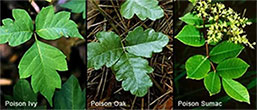 Poison ivy typically grows as a vine or shrub, and it can be found throughout much of North America. Poison ivy plants typically have leaf arrangements that are clustered in groups of three leaflets. The plant may have yellow or green flowers, and white to green-yellow berries, depending on the season. Poison oak also grows as a vine or shrub and is found in the western United States and British Columbia. It has a leaf arrangement similar to poison ivy. Poison sumac on the other hand, grows as a shrub or small tree and is only found in eastern/southeastern United States. When infected by one of these, you get a rash within 12-72 hours. Skin may become red, swollen and/or itchy. Rash usually appears bumpy, streaky and linear. Fluid may discharge from blisters but isn't contagious. Within 20-30 minutes of exposure, rinse the affected area with lots of warm water to remove the oily plant resin. You can also use soap or rubbing alcohol to help with the resin removal. The rash slowly improves and disappears after one to three weeks in most individuals. For more information about poison ivy, click here.
If you're looking for homemade remedies for poison ivy, click here to read an interesting article from TipsBulletin!
Poison ivy typically grows as a vine or shrub, and it can be found throughout much of North America. Poison ivy plants typically have leaf arrangements that are clustered in groups of three leaflets. The plant may have yellow or green flowers, and white to green-yellow berries, depending on the season. Poison oak also grows as a vine or shrub and is found in the western United States and British Columbia. It has a leaf arrangement similar to poison ivy. Poison sumac on the other hand, grows as a shrub or small tree and is only found in eastern/southeastern United States. When infected by one of these, you get a rash within 12-72 hours. Skin may become red, swollen and/or itchy. Rash usually appears bumpy, streaky and linear. Fluid may discharge from blisters but isn't contagious. Within 20-30 minutes of exposure, rinse the affected area with lots of warm water to remove the oily plant resin. You can also use soap or rubbing alcohol to help with the resin removal. The rash slowly improves and disappears after one to three weeks in most individuals. For more information about poison ivy, click here.
If you're looking for homemade remedies for poison ivy, click here to read an interesting article from TipsBulletin! |
| |
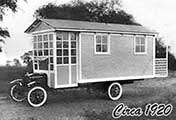 The RV industry has evolved tremendously over the last 100 years! This industry directly and indirectly supported an estimated 67,200 jobs and delivered $4.8 billion in added economic value to the Canadian economy in 2019. It is estimated that approximately 2.1 million Canadian households currently own an RV and this number has been increasing exponentially since Covid-19 began! With more than 4,300 campgrounds across Canada, additional investments in our camping and RV infrastructures is likely to improve the Canadian tourism industry.
If you want to view pictures of RV's over the last 100 years, click here.
The RV industry has evolved tremendously over the last 100 years! This industry directly and indirectly supported an estimated 67,200 jobs and delivered $4.8 billion in added economic value to the Canadian economy in 2019. It is estimated that approximately 2.1 million Canadian households currently own an RV and this number has been increasing exponentially since Covid-19 began! With more than 4,300 campgrounds across Canada, additional investments in our camping and RV infrastructures is likely to improve the Canadian tourism industry.
If you want to view pictures of RV's over the last 100 years, click here. |
| |
Parks Canada recently announced that they will double the number of its new 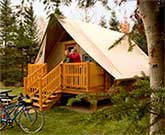 "oTENTik" camping structures in national parks and other locations across the country this year! An "oTENTik" structure is basically a crossbetween a tent and a cabin and is intended to add a degree of comfort to camping (see "Glamping" below). After rolling out a few dozen of the units in 2013, initially at La Mauricie National Park in Quebec, Parks Canada made 124 available across the country last year, mostly in national parks but also at a couple of national historic sites in B.C. This year the number of units will hit 238, said Francois Duclos, Parks Canada manager of visitor experience infrastructures and the rental cost ranges from $90-$120 a night for a unit that can accommodate six people. Click here for more information! "oTENTik" camping structures in national parks and other locations across the country this year! An "oTENTik" structure is basically a crossbetween a tent and a cabin and is intended to add a degree of comfort to camping (see "Glamping" below). After rolling out a few dozen of the units in 2013, initially at La Mauricie National Park in Quebec, Parks Canada made 124 available across the country last year, mostly in national parks but also at a couple of national historic sites in B.C. This year the number of units will hit 238, said Francois Duclos, Parks Canada manager of visitor experience infrastructures and the rental cost ranges from $90-$120 a night for a unit that can accommodate six people. Click here for more information!
|
| |
Camping in style!!
Have you ever heard of "Glamping"? No.... well, you're not alone! "Glamping", which stands for "glamorous camping",started in Europe a decade ago. No more kerosenelamp, no mor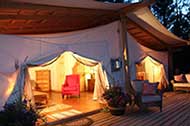 e heating a can of beans on a campfire! Hello solar lamps, bed, kitchen-range, comfy chairs.... all under a tent! Europeans refer to these places as "open air hotels". Now, it's starting to catch on in Canada! Some setup are simply large canvas tents with some furniture such as a chair and a bed while others offer more luxury. Prices range from under $100 for a single night with a cot, to around $1000 for four nights with a queen bed!
At the moment, glamping is more popular in BC but it's slowly catching on in the rest of canada. Click here to view a map of Glamping spots in Canada. e heating a can of beans on a campfire! Hello solar lamps, bed, kitchen-range, comfy chairs.... all under a tent! Europeans refer to these places as "open air hotels". Now, it's starting to catch on in Canada! Some setup are simply large canvas tents with some furniture such as a chair and a bed while others offer more luxury. Prices range from under $100 for a single night with a cot, to around $1000 for four nights with a queen bed!
At the moment, glamping is more popular in BC but it's slowly catching on in the rest of canada. Click here to view a map of Glamping spots in Canada. |
| |
"Survey says"....
Did you know that 85% of campers feel that campground  owners charge too much for firewood and that close to 65% of campers think that campground owners should not use coin-operated showers? These are some of the findings of our survey with over 20,000 participants so far. To find out more, click here to take our survey and see all the survey results. owners charge too much for firewood and that close to 65% of campers think that campground owners should not use coin-operated showers? These are some of the findings of our survey with over 20,000 participants so far. To find out more, click here to take our survey and see all the survey results.
|
|
|
|